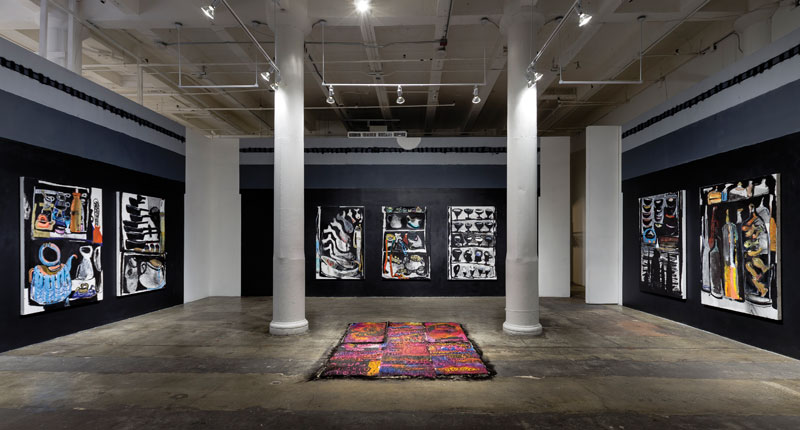« Reviews
Summer Wheat: Walk-in Pantry
Fridman Gallery - New York
By Owen Duffy
Summer Wheat continually experiments with what painting can do, what it can become, and the narratives that have constructed its grand tradition. For her most recent endeavor at Fridman Gallery, “Walk-in Pantry,” Wheat created what amounts to art historical parafiction-with, as art historian Carrie Lambert-Beatty would say, “one foot in the field of the real.”1 Taking Johannes Vermeer’s The Milkmaid, an illusionistic 17th-century masterpiece of a domestic servant pouring milk, as a point of departure, Wheat presents viewers with a wonderfully strange glimpse into what the milkmaid’s pantry could have been.
Wheat’s seven paintings are gritty and dramatic. A liberal application of charcoal gives these discrete views into the Milkmaid’s pantry, such as the painting Reflection, a weighty material presence. Negative space is made into a thing. In turn, Wheat uses the “thingness” of the negative space, contradictorily forging physical presence rather than absence, to give form to the sundry objects rendered in Reflection-bottles, jars, and what appears to be a slice of cake. Within one of the bottles, wide-eyed fish congregate. All their bodies turn toward another bottle streaked with peach, yellow, and ginger. Perhaps enamored with their own reflections, they lead our eyes to the center of the composition. Wheat’s quirky hand anthropomorphizes the pantry’s odds and ends, transforming bottles, food, and the like into energetic supporting characters for her parafictional world.
Rather than hanging paintings in a white cube, Wheat has installed her new works on walls painted black and gray. Around the highest gray stratum, Wheat outlined a black, sketchy frieze, replete with triglyphs-like forms. This modest faux-architectural addition sets up an interplay with the gallery’s imposing columns in the center of the room. Together, they begin to recast the space as a kind of temple. Driving this experience home, Wheat blacked out the windows of the gallery’s apses, save for two small, square transparencies-self-descriptively titled Oranges and Bananas. Made from resin, ink, and vinyl, these works function like stained glass, allowing polychromatic light to filter through. Wheat has thus imagined the milkmaid’s pantry-a domestic space-as a quasi-spiritual site, part temple, part church.
Swept Under the Rug, the acme of “Walk-in Pantry,” occupies the center of the space. To create this multi-paneled piece, Wheat pressed vibrant, almost psychedelic pigment through a window screen. This process bestows each panel with a tactile, fibrous surface, like short shag. With ink, Wheat scrawled a dumpling recipe over the textured paint. The panels rest over a bed of granular charcoal, a gesture that suggests the Milkmaid, a largely anonymous historical character, had dirt of her own, secrets, and a life not fully represented in the Vermeer original. We can read Swept Under the Rug as an endearing conflation of many things: painting and sculpture, text and image, past and present.
What makes Wheat’s Walk-in Pantry successful is how the work mines art history, not simply for sake of being clever or demonstrating the artist’s self-awareness, but to open up a clearing where the viewer can inscribe contemporary urgency onto the past. Vermeer’s nameless milkmaid, though sensitively depicted, is painted as a type. Wheat’s Walk-in Pantry constructs an alternate world for this subject, restoring her individuality via the artist’s own haphazard, expressionistic, and visceral touch. In the contemporary context, giving the milkmaid such a tribute, such a life-no matter how imagined-critiques the notion of domestic servitude defining her identity or any woman’s. By deeming this worker worthy of such an exploration, Wheat initiates a discourse on status, class, and gender that warrants further exploration: questioning who can participate in an increasingly stratified contemporary art world.
(March 14 - April 25, 2015)
Notes
1. Carrie Lambert-Beatty, “Make Believe: Parafiction and Plausibility,” October 129, (Summer 2009): 54.
Owen Duffy is a Ph.D. candidate studying contemporary art history at Virginia Commonwealth University, a curatorial assistant at the Virginia Museum of Fine Arts, and a consulting editor for ARTPULSE.
Filed Under: Reviews




































Leave a Reply
You must be logged in to post a comment.